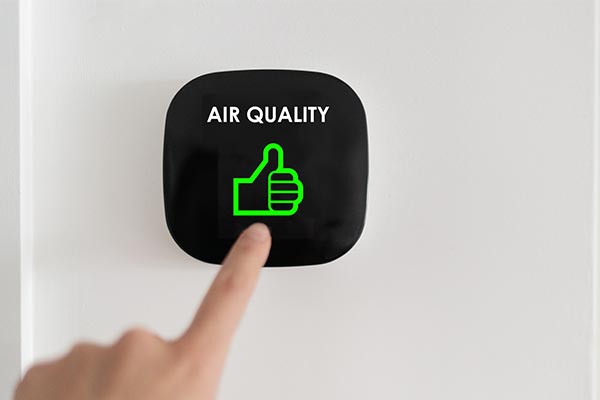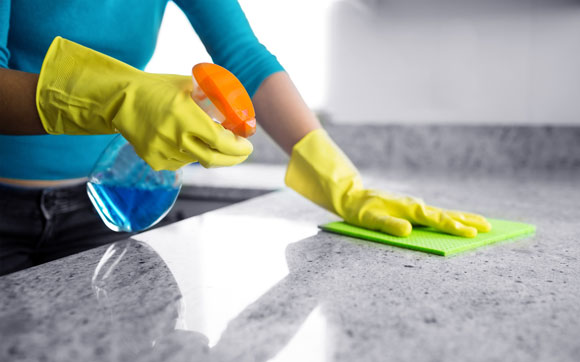How To Remove Mold Spores From The Air
In this comprehensive post, we'll go over the following;
Everything you need to know about removing mold spores from the air.
You'll learn;
- Dangers of Mold Spores,
- How to Prevent them from Settling,
- About CADR,
- Air Purifiers, and
- Preventing Mold.
So if you've ever wondered about any of these points, you'll love this post!

Contents
What Are Mold Spores

Mold spores are tiny particles that travel through the air. They are invisible to the naked eye and can stay in the air indefinitely. Unless a situation of high moisture arises, you would typically not know if any mold spores are near you. Mold spores need very precise conditions to grow and reproduce.
Mold spores are everywhere, and you can't get rid of them all. However, you can reduce the amount of mold in your home by keeping it dry and well-lit.
Dangers of Mold Spores
Mold spores are generally present in the air, even inside our homes. However, most of the time, they aren’t harmful or dangerous to humans. In high enough concentrations, however, they may cause respiratory symptoms like sneezing, coughing, runny noses, and irritation.
If you're allergic to mold, you may have more severe reactions. For many homeowners, mold is tough to spot and get rid of, and its spores in the air can cause allergy symptoms. But there are ways to reduce, remove, and eliminate mold spores in the air.
Preventing Mold Spores from Settling
Air purifiers and air cleaners remove airborne pollutants from your home, including mold spores. They draw air into the system and pass it through filters to capture and remove microscopic particles. This is just a quick and temporary measure to keep mold spores from settling. As mold spores are naturally released into the air, the key is to keep them moving and circulating out of your home.
Read on to see how to remove mold spores from the air in your home or business.
Increase Airflow & Ventilation
Moisture in the air is the culprit for mold spores. Generally, it takes about 4 hours for enough moisture to build up in the air. If the spores are allowed to settle, they will be everywhere, including your counters, furniture, floors, and other surfaces.
Microscopic mold spores are lightweight and will move around fairly quickly. The slightest draft or breeze can remove these spores from your home.
One of the best ways to do so is by having a window open. It is recommended to have it open for at least 10-30 minutes daily. Fresh air can come in, and mold-spore-contaminated air can go out. If you can, create a cross-breeze to flow the air throughout the area.
When cooking or using the shower, you should use ventilation fans. The fans are meant to draw moisture up and out of the room. If a window or door is open, the fan won't be able to do its job (so keep them shut). If you don’t have a working exhaust fan, open the windows and doors to allow the warm, moist air out.
Use Dehumidifiers
Use dehumidifiers to keep humidity low and prevent mold growth. Place them in problem areas or rooms with visible mold. If you're unsure which rooms the mold comes from, use a whole-house dehumidifier linked to your central air system—set dehumidifiers to 50% humidity or lower.
Use Air Purifiers
One of the most effective ways of spore mold removal from the air is by using an air purifier. For effectiveness, these can be placed in every room, or you can install a whole home/business air purifier. If only a specific area is of concern (basement, bathroom, bedroom, living space), then a smaller system will still work.
Most Air Purifiers use a HEPA (high-efficiency particulate air) filter to combat mold. HEPA filters trap microscopic particles from the air. True or Absolute HEPA filters must meet efficiency standards and capture a minimum of 99.97% of pollutants down to 0.3 microns in size. When installing HEPA filters, they need to be changed frequently, just like other filters, to ensure your home remains clear of contaminants.
When choosing an air purifier, ensure it has enough power to work in the room it will be placed in. The CADR can determine this, which you can read about below. Depending on the size of the space, it can take anywhere from 30 minutes to several hours for the air to become pure. For best results, the air purifier should run 24/7 to maintain purity.
What Is CADR?
The Clean Air Delivery Rate (CADR) is a standard measurement developed by AHAM to allow consumers to compare air purifiers' performance. It is recognized by the U.S. Environmental Protection Agency (EPA) and American Lung Association. The higher the CADR numbers, the faster and more clean air the unit can deliver.
The Association of Home Appliance Manufacturers conducts CADR tests to determine an air purifier's effectiveness in removing specific pollutants, like dust, pollen, and smoke. The results are usually printed on the air cleaner's box or manual. You can find more information about the CADR ratings on AHAM's official website.
The CADR Needed
It is essential to know the size of your room when buying an air purifier, as a purifier that is too small will not be effective. To find the right size air purifier for your needs, use AHAM's 2/3 rule. This rule states that the purifier's CADR (clean air delivery rate) must be at least two-thirds of the size of the room you want to purify.
So, for example, if you want to cover a 200-square-foot space, the CADR must be at least 133 cfm. Remember that the higher the CADR output, the faster and more effective the purifier will be.
CADR x 1.55 = Room size in square feet.
ft2 x ft (ceiling height) = Room size in cubic feet.
How Big of An Air Purifier Do I Need?

Air Purifiers
Knowing which room or rooms you'll use your air purifier in is vital before purchasing one. Depending on the size of the room or rooms, you'll need an air purifier with a specific airflow capacity. For example, a 300-square-foot room requires an air purifier with a minimum airflow capacity of 300 square feet per hour.
To calculate the size of the room, you need to purify, measure the room's length and width, and multiply the numbers to get the room's square footage. For example, if the room is 10 feet long and 11 feet wide, the square footage is 110. If you want to use a large air purifier for multiple rooms, add up the square footage of each room. For example, if you have a 200-square-foot living room and a 180-square-foot dining room, the total square footage is 380.
Ozone Generator
Ozone does not effectively remove viruses, bacteria, mold, or other biological pollutants when used at concentrations that do not exceed public health standards. Some data suggest that low ozone levels may reduce airborne concentrations and inhibit the growth of some biological organisms. In contrast, ozone is present, but higher concentrations would be needed to decontaminate the air sufficiently to prevent the survival and regeneration of the organisms once the ozone is removed.
MECHANICAL FILTERS VS. ELECTRONIC AIR CLEANERS
Maintaining a comfortable indoor temperature is essential for most homeowners, but indoor air quality can be just as important. High amounts of dust, pet dander, allergens, and bacteria can make life miserable if they become prominent enough. The good news is that adding an air filtration system to your heating and air conditioning can keep indoor air quality high.
Most heating and air conditioning units have a mechanical filter "built-in," a spot where you can slide a replaceable filter into place and improve your air quality. However, if you don’t clean or replace them regularly, their effectiveness will decrease since mechanical air filters work by trapping particulates in the filter material.
We recommend electronic filters over mechanical filters for any household with sensitive members, lots of pets, or a general tendency towards increased air dust levels. Electronic filters use static electricity to pull particles into a collector, which can be cleaned off. They tend to be more expensive than mechanical filters, but they tend to be more effective as well.
Preventing Mold

- If you notice something leaking, resolve the problem immediately to prevent more leaking. Anything leaking or spilled should be cleaned up and dried immediately.
- Keep your indoor humidity at 50% or less to keep moisture at bay
- Use exhaust fans and windows to keep spaces like kitchens and bathrooms free of moisture buildup
- Keep common mold-growing areas clean, such as bathroom tiles and shower curtains (can use a vinegar base cleaner)
- Read the EPA’s A Brief Guide to Mold, Moisture, and Your Home to learn more about mold prevention.
If you find more mold than you can handle in your home or business, call the professional mold remediation team at Rock Environmental to eliminate your mold problem. Not only will they give you peace of mind, but they will also give you fast solutions and bring your space back to its pre-mold condition!
Share this Post
